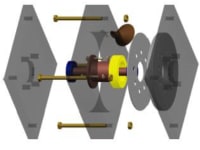All the moving vehicles under motion generate wind quite sufficient to generate small electricity through wind turbines. Placing a wind turbine on the top of the locomotives is another challenge. On the grounds of conservation of energy our idea is to use the wind energy we experience from moving vehicles for power generation. A speeding train, for instance, produces tremendous gusts that can just as easily be converted into electricity. In the current project we are developing a compact Tesla turbine which serves our need of generating power and also mounting of Tesla turbine on top of the locomotives is easy, as the current model is compact in nature. Further, a lot of fuel is wasted in air conditioning systems in vehicles. The following stages are there in designing the current prototype:
Stage 1-Design of Tesla Turbine: Tesla turbine doesn't have any blades. It has a series of closely packed parallel disks attached to a shaft and arranged within a sealed chamber. When a fluid is allowed to enter the chamber and pass between the disks, the disks turn, which in turn rotates the shaft. While a traditional bladed turbine would need large volumes of low velocity fluid, the Tesla turbines require high velocity fluid accurately guided in lower volumes.
Stage 2-Design of Power generation unit: This unit consists of motor, dynamo and battery. The amount of power generated depends upon the wind speed and vehicle speed, hence it is better to charge a battery with fluctuating power.
Stage 3-Artificial cooling units: The artificial cooling unit consist of fan, air filters, 2 stage nozzles and humidity absorption unit.
Working procedure: The tesla turbine is mounted on to the roof top of a train. A nozzle is fitted to the tesla turbine to increase the speed of rotor rotation by increasing wind pressure through nozzle. The turbine is then coupled with the dynamo and to generator. The power generated is used to charge a battery and from the battery the power can be utilized to run small electrical appliances in the train. A detailed experimental study can help us calculate the number of tesla turbines required to meet the power requirement per compartment. The current idea will be tested only on express trains or vessels / express bus [Volvo/Mercedes etc.,] as the motion of locomotives will be for a longer time with less halts and greater speeds. The air is then passed through a series of wet filters and air filters thus helping in adiabatic heat exchange with dust filtering and humidity absorption. Thus we will be able to produce a natural air conditioning system within the train, bus or other locomotives and help in reduction of power usage for air conditioning systems. So, this nozzle setup due to it's components has less moving moving parts and has less maintenance costs comparatively.
Like this entry?
-
About the Entrant
- Name:Sobhan Prem Sai Koppuravuri
- Type of entry:teamTeam members:Sobhan Prem Sai Koppuravuri,
P.Sai Sri Harsha,
K.A.Udaya Kumar - Software used for this entry:Pro-E
- Patent status:none








